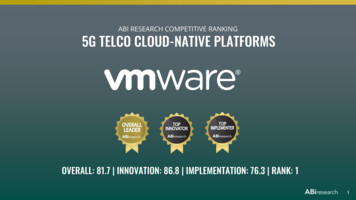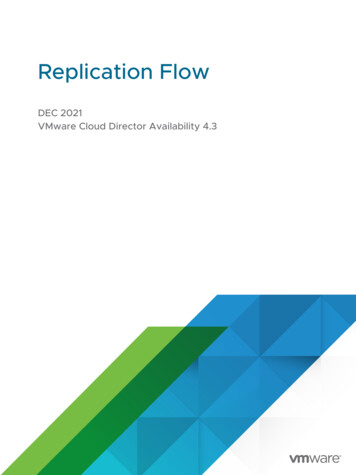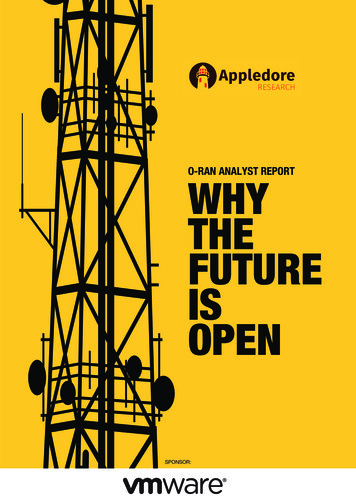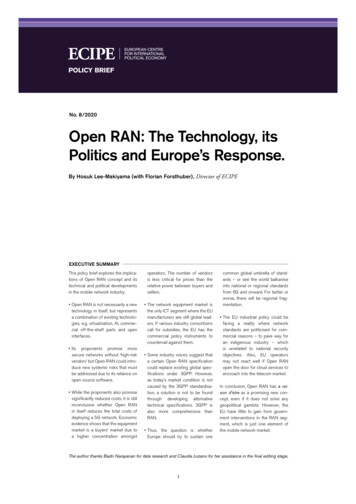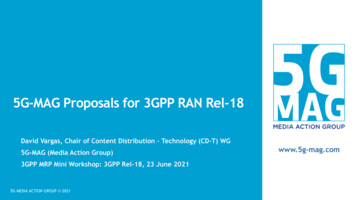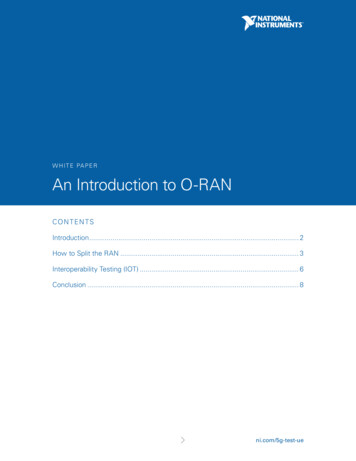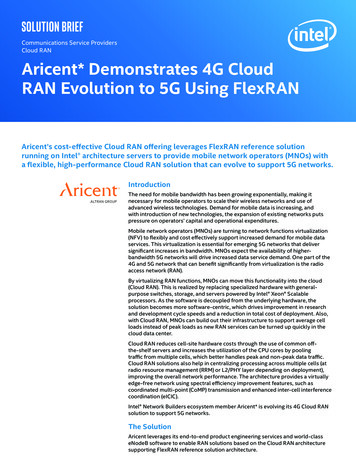
Transcription
Solution briefCommunications Service ProvidersCloud RANAricent* Demonstrates 4G CloudRAN Evolution to 5G Using FlexRANAricent’s cost-effective Cloud RAN offering leverages FlexRAN reference solutionrunning on Intel architecture servers to provide mobile network operators (MNOs) witha flexible, high-performance Cloud RAN solution that can evolve to support 5G networks.IntroductionThe need for mobile bandwidth has been growing exponentially, making itnecessary for mobile operators to scale their wireless networks and use ofadvanced wireless technologies. Demand for mobile data is increasing, andwith introduction of new technologies, the expansion of existing networks putspressure on operators’ capital and operational expenditures.Mobile network operators (MNOs) are turning to network functions virtualization(NFV) to flexibly and cost effectively support increased demand for mobile dataservices. This virtualization is essential for emerging 5G networks that deliversignificant increases in bandwidth. MNOs expect the availability of higherbandwidth 5G networks will drive increased data service demand. One part of the4G and 5G network that can benefit significantly from virtualization is the radioaccess network (RAN).By virtualizing RAN functions, MNOs can move this functionality into the cloud(Cloud RAN). This is realized by replacing specialized hardware with generalpurpose switches, storage, and servers powered by Intel Xeon Scalableprocessors. As the software is decoupled from the underlying hardware, thesolution becomes more software-centric, which drives improvement in researchand development cycle speeds and a reduction in total cost of deployment. Also,with Cloud RAN, MNOs can build out their infrastructure to support average cellloads instead of peak loads as new RAN services can be turned up quickly in thecloud data center.Cloud RAN reduces cell-site hardware costs through the use of common offthe-shelf servers and increases the utilization of the CPU cores by poolingtraffic from multiple cells, which better handles peak and non-peak data traffic.Cloud RAN solutions also help in centralizing processing across multiple cells (atradio resource management (RRM) or L2/PHY layer depending on deployment),improving the overall network performance. The architecture provides a virtuallyedge-free network using spectral efficiency improvement features, such ascoordinated multi-point (CoMP) transmission and enhanced inter-cell interferencecoordination (eICIC).Intel Network Builders ecosystem member Aricent* is evolving its 4G Cloud RANsolution to support 5G networks.The SolutionAricent leverages its end-to-end product engineering services and world-classeNodeB software to enable RAN solutions based on the Cloud RAN architecturesupporting FlexRAN reference solution architecture.
Solution Brief Aricent* Demonstrates 4G Cloud RAN Evolution to 5G Using FlexRANFlexRAN SolutionFlexRAN is a software-based radio reference architecturedeveloped by Intel to enable Cloud RAN in a variety offlexible configurations. The block diagram in Figure 1 showsthe FlexRAN PHY Application, which takes radio signals fromthe RF front-end and provides real-time signal and physicallayer processing adapted for servers that use Intel XeonScalable processors and Intel Xeon D processors.Supporting this functionality is the FlexRAN SDK, whichprovides optimized signal processing libraries for Intel architecture CPUs; the FlexRAN Task Controller, whichfacilitates scaling across multiple CPUs; and the DataPlane Development Kit, which delivers platform servicessuch as high-throughput packet forwarding and memorymanagement. The FlexRAN platform is designed to run onWindRiver Titanium Server* as the NFV infrastructure.FlexRAN Reference PHY Application3GPP Release 10 5G NR in developmentFlexRAN TestInfrastructureTest MACFlexRan SDKFlexRan TaskController(module levelkernels optimized forIntel architectureinstruction set)Test App(task orientedsoftware architecturefor task distribution)PlatformServicesDPDKNFVI(Wind River Titanium Server)Unit TestsRadio ModeTestingIntel ProcessorsIntel NetworkCardsAccelerationOptionsIntel Xeon ScalableProcessors, Intel Xeon D ProcessorsIntel GigabitEthernet ControllerIntel FPGAIntel QuickAssistTechnology1Figure 1. FlexRAN architectureAricent Cloud RAN Solution Based on FlexRANThis FlexRAN solution was chosen by Aricent because itaccelerates time to market for its solution. An importantfeature to the Aricent solution is FlexRAN’s ability to enableand optimize macro- and small-cell solutions and supporthigh-capacity and low-capacity use cases for rural anddense environments. The Aricent solution complies with allindustry standards set by the 3GPP,* TIP,* and the Open RAN(O-RAN) Alliance,* making it interoperable with other vendorsolutions.Aricent offers mature and proven eNodeB softwareframeworks for realizing Cloud RAN solutions. For 5G, theAricent Software Framework solution supports fronthaulinterfaces including enhanced common public radiointerface (eCPRI) and radio over Ethernet (RoE) based on theO-RAN interface specification. The company is working withIntel to integrate the software framework with Intel’s sub-6GHz and millimeter-wave reference solutions.Aricent Cloud RAN benefits from network functionvirtualization (NFV) for the centralized processing ofwireless functions.As shown in Figure 2, Aricent offers a flexible architecturewith different functional splits and fronthaul interfaceoptions. In this architecture: Central unit (CU) functionality includes operations,administration, and management (OAM), RRM/selforganizing network (SON), layer-three routing, and packetdata convergence protocol (PDCP). Distributed unit (DU) delivers radio link control (RLC),media access control (MAC) and upper-PHY or completePHY services (as applicable). Remote radio unit (RRU) corresponds to radio part andlower-PHY (as applicable).Realization of RAN Split Option 7-xThere are multiple deployment options that can be realizedfor 4G LTE virtualized-RAN architecture (using FlexRANarchitecture), and salient factors of the Aricent solutioninclude the following: Support for both Ethernet-based fronthaul and commonpublic radio interface (CPRI)-based fronthaul In Ethernet-based fronthaul, there are multipledeployment options that are available:2
Solution Brief Aricent* Demonstrates 4G Cloud RAN Evolution to 5G Using FlexRANeNB: Intel Xeon Processor-Based ServerRRUMAC/RLCOption 1ETHERNETPHY/L1RRCRRMARICENT wer-L1Option 2MMEETHERNETRFSON RRMPDCPGTPRRCUPPER-L1ETHERNET (S1)S1-URRUOption 3RRCCPRIRFRRMPDCP/GTPSONARICENTEPCMAC/RLCPHYFigure 2. Aricent RAN split options* Option 1: CU DU and RU-based architecture withEthernet as fronthaul based on RAN Split Option 7.x(OR) Option 2: CU, DU and RU-based architecture withEthernet fronthaul based on RAN Split Option 7.x (andoption 2 split between CU and DU) Option 3: CU DU and RU-based architecture with CPRIas fronthaul based on RAN Split Option 7.xThe Aricent software architecture for an Option 2 type ofsplit with RAN Split Option 7-x, running on an Intel Xeonprocessor-based server, is shown in Figure 3.Central Unit 1L3 VMOAMSONRRMGTP-ULayer 3S1-AP (IP)VM Guest OS: CentOSS1-U (IP)L2 - U VMEPC(Aricentor 3rdParty)PDCPVM Guest OS: CentOSL2 - L & L1- U VMMAC/RLC -1L1-UVM Guest OS: CentOS.Linux bridge /Aricent DPDKvSwitch.L2 - L & L1- U VMX2-AP (IP)MAC/RLC -nL1-UX2-U (IP)VM Guest OS: CentOSeNB(Aricentor 3rdParty)Intel Xeon processor-based server/Wind River Linux with DPDKL1-LL1-LRadio Unit – Cell 1Radio Unit – Cell 2RFRFIntel L1Third PartyComponents.L1-LRadio Unit - Cell nRFAricent eNB framework components(with modifications)Ethernet i/fFigure 3. Aricent virtualized-RAN architecture*3
Solution Brief Aricent* Demonstrates 4G Cloud RAN Evolution to 5G Using FlexRANThe key aspects of the Aricent solution supporting OAM,RRM/SON, layer 3, layer 2, and layer 1 include the following: Running stack components as part of different VMs givesthe flexibility to scale up/down the solution across thecentral unit. Single S1 and X2 interface endpoints on a CU for all thecells. S1-AP and X2-AP for all the cells terminate at L3 VM on the CU. Layer 1 can be flexibly split in upper layer 1 and lowerlayer 1 in the following ways: S1-U and X2-U terminate at layer 2 VM of the CU. Layer 2can use the Data Plane Development Kit (DPDK) for datapath acceleration. After upper layer 1 processing, data isforwarded to the respective cell’s lower layer 1 running onDU. Option 1: Complete layer 1 shall be running in RU. Option 2: Upper layer 1 running on an Intel Xeonprocessor-based server and lower layer-1 running onRRU; upper and lower layer 1 interact using DPDKenhanced transport mechanism. Multiple lower layer 2 instances, each serving multiplecells (with support for carrier aggregation). Option 3: Complete layer 1 is running on an Intel Xeonprocessor-based server. Aricent eNodeB stack components are built in amodular way to support virtualization and use the DPDKaccelerator provided by Intel Xeon processor-basedserver to improve the system performance. Support for baseband unit (BBU) pooling framework inboth layer 1 and layer 2 software for efficient usage ofcores and improving the core-utilization factor.L1-L2 (VM)DL ChainPRACH FrontProcessingCP removal & Half CyclicShift and FFTUL ChainWLSPDCPUL RLCDL & ULSchedulerHARQManagementLinkAdaptionL1-L2 nt, DPDKUL RLCRB Selection & IFFTVMMACPHYControllerPHYVMeGPTUPRACHCompression /DecompressionRRC S1AP X2APControl SAPControlHandlingCPRI ConversionVMEncoder (MAC) DL RLCDL RLCOAMRRMMACEncoderProcessSONFunctional BlockThreadsFigure 4. Aricent virtualized-RAN architecture*The key benefits of virtualized RAN architecture include: Solution can be run on virtualized general-purposeprocessors (along with field programmable gate array(FPGA) for high-processing requirements like forwarderror correction, fronthaul processing, etc.). Efficient scaling of resources (and cores) and scalability ofthe solution to meet capacity/performance requirements. Load balancing of resources. Concepts of pooling are employed for efficient utilizationof compute resources. Leveraging the concept of centralized processing at layer 2.5G Roadmap with FlexRANAricent and Intel have also collaborated in the 5G FlexRANto develop a virtualized RAN solution based on 3GPP Rel15 specifications for both sub-6 and mmWave scenarios,with the plan to leverage the 4G FlexRAN architecture asa baseline and enhance it to meet 5G requirements. Nonstandalone (NSA) mode is currently under verificationfollowed by support for standalone (SA) mode.Ethernet-based fronthaul is being considered for 5Gvirtualized-RAN deployment and like 4G case, the focus ison RAN Split Option-7.x (and in some deployments haveOption-2 and Option-7.x split).The high-level software deployment model for 5G NSA(combining 4G and 5G FlexRAN) is shown in Figure 5. In thebelow architecture, CU and DU shall be running on Intel Xeonprocessors, with PHY/layer-1 running in an Intel Xeon serveralong with the RRU (for Option-7.x split).To support use-cases and scenarios with low-latencyrequirements, Aricent multi-access edge computing (MEC)solution can also be integrated as part of CU for 5G baseddeployments.4
Solution Brief Aricent* Demonstrates 4G Cloud RAN Evolution to 5G Using FlexRANEPCMCGbearerSplitbearerPGWMMESGWMeNB5G SGNB-Central Unit (CU)PDCP eGTPUPDCP eGTPURLCRLC5G L2-U5G L3 ,F1AP)LTE L1Air InterfaceF1-U Interface5G/4G Non-standalone UE4GDistributed Unit (DU)5GRRCRRCPDCPPDCPRLCRLCMACMACOAMAir InterfaceDUMGRF1-URLCMAC5G L1AricentIntelFigure 5. 5G non-standalone software deployment*Support for Artificial Intelligence/Machine Learning in RANWith networks becoming more complex, it is important tomake the network more intelligent and autonomic. Thiscan be achieved by applying artificial intelligence (AI) andmachine learning(ML) techniques to the network. Some ofthe areas where AI can be applied include the following: Operations support system (OSS) plane Core network (CN) Multi-access edge computing (MEC) RANWithin the RAN, the application of AI/ML can be categorizedinto two areas: real-time processing and non-real-timeprocessing.The ML model for real-time processing functionality includesbeam-forming, link-adaptation/power control, and otherclosed-loop functionality procedures that involve the airinterface, while the ML model for non-real-time processingfunctionality includes handover optimization, mobilitymanagement, quality of experience (QOE) optimization, andrelated RRM/SON procedures.As part of the 5G virtualized-RAN roadmap, Aricent plans tointegrate the ML models within CU and DU and provide anintegrated solution to customers on Intel -based platforms.ConclusionAricent works with original equipment manufacturers todevelop and customize their LTE and 5G solution supportingFlexRAN architecture. By customizing the RAN solution as perFlexRAN architecture, Aricent virtualized-RAN based solutioncan deliver significant business value, including: Reducing risk through feature-rich and carrier-gradeofferings. Accelerating time-to-market. Solution availability on generic platforms. Extensive partner ecosystem with RRH suppliers. End-to-end product engineering services for Cloud RANincluding consulting, design, development, integration,testing, support, and maintenance for a one-stop solutionfor all engineering needs. Built-in flexibility for faster market response.5
Solution Brief Aricent* Demonstrates 4G Cloud RAN Evolution to 5G Using FlexRANAbout AricentLearn MoreAricent is a global design and engineering companyinnovating for customers in the digital era. We help ourclients lead into the future by solving their most complexand mission critical issues through customized solutions.For decades, we have helped companies do new thingsand scale with intention. We bring differentiated value andcapability in focused industries to help transform products,brands and companies. Based in San Francisco, frog, aglobal leader in innovation and design, is a part of Aricent.Aricent is a part of the Altran Group.Find out more about what Aricent software frameworkssolutions can do for your company. To set up a call ormeeting with an Aricent expert today, email marketing@aricent.com.About Intel Network BuildersIntel Network Builders is an ecosystem of infrastructure,software, and technology vendors coming together withcommunications service providers and end users toaccelerate the adoption of solutions based on networkfunctions virtualization (NFV) and software definednetworking (SDN) in telecommunications and datacenter networks. The program offers technical support,matchmaking, and co-marketing opportunities to helpfacilitate joint collaboration through to the trial anddeployment of NFV and SDN solutions. Learn more athttp://networkbuilders.intel.com.Intel technologies’ features and benefits depend on system configuration and may require enabled hardware, software or service activation. Performance varies depending on systemconfiguration. No product or component can be absolutely secure. Check with your system manufacturer or retailer or learn more at intel.com.Cost reduction scenarios described are intended as examples of how a given Intel- based product, in the specified circumstances and configurations, may affect future costs and provide costsavings. Circumstances will vary. Intel does not guarantee any costs or cost reduction.Optimization Notice: Intel’s compilers may or may not optimize to the same degree for non-Intel microprocessors for optimizations that are not unique to Intel microprocessors. Theseoptimizations include SSE2, SSE3, and SSSE3 instruction sets and other optimizations. Intel does not guarantee the availability, functionality, or effectiveness of any optimization onmicroprocessors not manufactured by Intel. Microprocessor-dependent optimizations in this product are intended for use with Intel microprocessors. Certain optimizations not specific to Intelmicroarchitecture are reserved for Intel microprocessors. Please refer to the applicable product User and Reference Guides for more information regarding the specific instruction sets coveredby this notice.Notice Revision #20110804All information provided here is subject to change without notice. Contact your Intel representative to obtain the latest Intel product specifications and roadmaps.Intel, the Intel logo, and Xeon are trademarks of Intel Corporation or its subsidiaries in the U.S. and/or other countries.* Other names and brands may be claimed as the property of others. Intel Corporation0519/DO/H09/PDFPlease Recycle340522-001US6
frameworks for realizing Cloud RAN solutions. For 5G, the . Aricent Software Framework solution supports fronthaul interfaces including enhanced common public radio interface (eCPRI) and radio over Ethernet (RoE) based on the O-RAN interface specification. The company is working with Intel to integrate the software framework with Intel's sub-6

